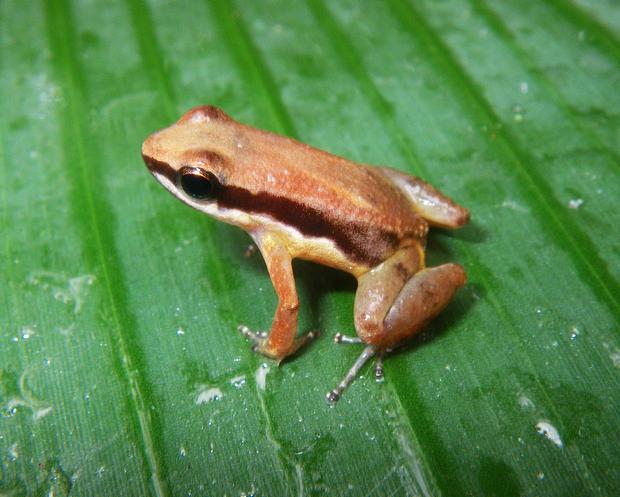A team of scientists from the Senckenberg Research Institute in Dresden were doing a study about the ways ecotourism and conservation can cohabitate nicely - and they discovered a new species of frog. As with most new discoveries, this micro-endemic species was immediately declared endangered because no one had seen it before.
Allobates amissibilis (Latin “that may be lost”) exists in a very confined area of the Iwokrama Forest at the foot of the Iwokrama Mountains. The area is part of the Guiana Shield in the north of South America and the setting for Arthur Conan Doyle's "The Lost World", written in 1912. It accounts for more than 25 percent of the world’s tropical rain forests and is one of the four remaining extensive pristine forested areas left in the world - the Amazon, Congo and Papua New Guinea are the others.
In a study sponsored by the Stiftung Artenschutz and the Verband Deutscher Zoodirektoren, the Dresden team led by biologists Dr. Raffael Ernst and Monique Hölting investigated the forests of Guyana as a test case for conservation of amphibians and ecotourism. Their idea is to test the concept of a truly sustainable forest, where conservation, biodiversity safeguarding, environmental balance and economic use can be mutually reinforcing. Ecotourism concepts are also being tested in the project area, Turu Falls, at the foot of the Iwokrama Mountains in the Iwokrama Forest of Central Guyana.
The original aim of the study was to investigate the populations of Hoogmoeds harlequin frog (Atelopus hoogmoedi), in order to find out whether these morphologically very variable frogs may be affected by the planned tourism activities. The results will lead in the medium term to a sustainable development plan for the area, with Atelopus receiving the role of a flagship species, which is a fancy name for a species which stands as representative for the protection of the entire area.
Yes, while visiting The Lost World they discovered a frog that did not know it was lost - and declared it virtually already lost.

Helloooo, I am not lost - Allobates amissibilis. Photo: M.Hoelting & R.Ernst/Senckenberg
The inconspicuous, brown poison dart frog is only the size of a thumbnail. As inconspicuous as the frogs appear, they are unique. To date, only three species of the genus Allobates are known from Guyana, one of which, the Cuckoo frog Allobates spumaponens, was described for the first time by the same team in 2007. The newly discovered little frog is the third known micro-endemic species, i.e. which only occurs in the very small area of the Iwokrama Mountains. So far, only a gecko and a caecilian, a legless amphibian, are known from this area as having a similarly limited distribution.
Because of their limited distribution and usually small total population sizes, micro-endemic species are particularly vulnerable to changes in their environment. It is therefore unknown whether the use of the area as a destination for ecotourism will lead to the loss of a species which has only just been discovered.
Citation: Kok, P.J.R., Hölting, M., Ernst, R. (in press 2013) A third microendemic to the Iwokrama Mountains of central Guyana: a new "cryptic" species of Allobates Zimmerman and Zimmerman, 1988 (Anura: Aromobatidae). Organisms Diversity and Evolution. Online first DOI: 1010.1007/s13127-013-0144-4




Comments